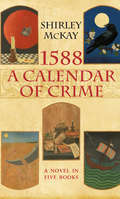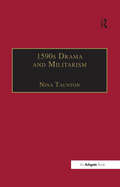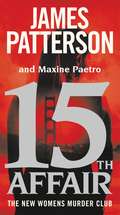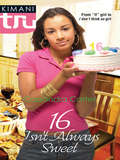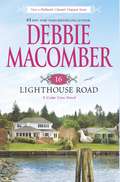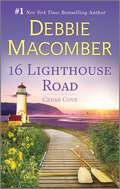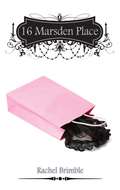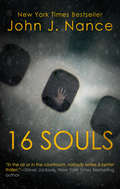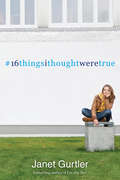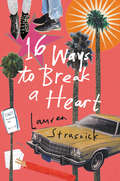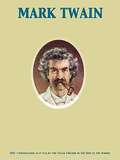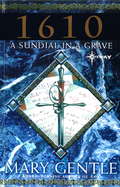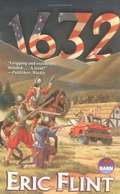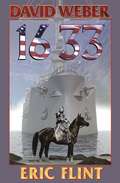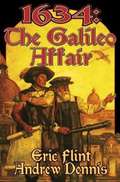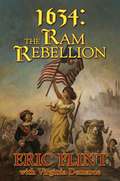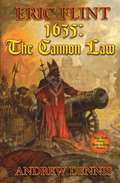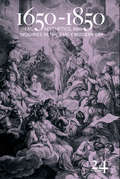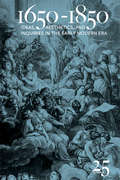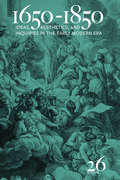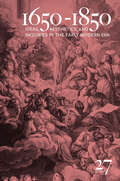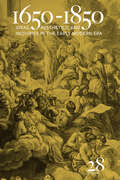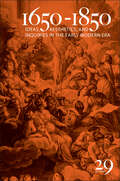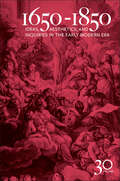- Table View
- List View
1588: A Novel in Five Books (The\hew Cullan Mysteries Ser. #6)
by Shirley McKayStories starring a sleuthing Scottish lawyer: &“McKay&’s command of plot, place and character makes these 16th century St Andrews-set mysteries a delight.&” —The Scotsman A grisly murder. A vanishing corpse. A secret romance. A ghostly tale. An innocent accused. Set in the year of the Armada, 1588: A Calendar of Crime brings together five short stories featuring Hew Cullan. From the gruesome murder of a candlemaker to Spanish ghosts on Hallowmas, Shirley McKay delivers five gripping tales of mystery that will keep you reading long into the night. &“A fascinating evocation of the everyday life of ordinary Scots in the 1500s as well as series of first-rate stories. Her use of language is a delight, the sinewy and expressive Scots words aiding the creation of Cullen's very realistic world. McKay is to be congratulated for the continued quality and inventiveness of her tales.&” —The National
1590s Drama and Militarism: Portrayals of War in Marlowe, Chapman and Shakespeare's Henry V
by Nina Taunton1590s Drama and Militarism is a fascinating interdisciplinary study of various textual interventions into the military realities of the late Elizabethan period. Its major strength is its insistence on the discursive nature of militarism, and the author convincingly uses literary and non-literary texts-including manuals and contemporary military correspondence-to reconstruct the particular anxieties which surrounded the military exigencies of the 1590s, a particularly fraught and unstable period of the aging queen's reign. The literature of the 'art of war' has been little studied by literary scholars, despite their richly rhetorical nature. Dr Taunton's analysis thus brings to light a neglected but culturally significant form of Renaissance textuality. In doing so she is able to shed new light on the Renaissance drama, which she shows to have responded sensitively (and sometimes critically) to these textual constructions of actual warfare, and problematised the anxious idealisations of the military manuals. The particular readings of plays here are richly rewarding for the scholar of Renaissance drama-the significance of Henry's nocturnal surveillance of his own camp on the eve of the battle of Agincourt, for example, benefits immeasurably from being contextualised in the light of contemporary theories of encampment. The role of the women in Tamburlaine's camp in Marlowe's plays is also given particular significance when viewed in the light of the contemporary proscriptions regarding the presence of women in camps during the military campaigns in the Low Countries. In this study Dr Taunton makes appropriate (and critically inflected) use of Foucault's theories of surveillance, Lefebvre's theories about the ideological production of social space, and Michel de Certeau's theories of social practice are put to good use in her analysis of military strategy. These theoretical perspectives are usefully combined with highly specific and well-documented historical analyses.
15th Affair (Women's Murder Club Ser. #15)
by James Patterson Maxine Paetro<P>Detective Lindsay Boxer chases an elusive suspect...her husband. <P>As she settles into motherhood and a happy marriage, Lindsay Boxer thinks she has found domestic bliss. But when a beautiful, alluring blonde woman with links to the CIA disappears from the scene of a brutal murder at a downtown luxury hotel, Lindsay's life begins to unravel. <P>Before she can track down the woman for questioning, a plane crash plunges San Francisco into chaos and Lindsay's husband Joe vanishes. The deeper she digs, the more Lindsay suspects that Joe shares a secret past with the mystery blonde. Thrown into a tailspin and questioning everything she thought she knew, Lindsay turns to the Women's Murder Club for help as she tries to uncover the truth. <P> Filled with pulse-pounding international intrigue, 15TH AFFAIR proves that all is fair in love, war, and espionage. <P><b>A New York Times Bestseller</b>
16 Isn't Always Sweet
by Cassandra CarterFrom best friend to frenemy to flat-out enemy For her Sweet Sixteen, Jordan Wright gets rid of the frizzy hair, the conservative clothes, and finally likes the hip new girl smiling in the mirror. So when she hears about an open casting call for the hottest rapper's new video, she has the confidence to go for it. She and her best friend, Adrienne, try out with hundreds of hopefuls, but only Jordan makes it. Adrienne seems fine with it. But when Jordan starts getting some serious attention, Adrienne turns into a hater. And after Jordan has an innocent in-the-hall conversation with Adrienne's ex-boyfriend--they dated for one week, like four years ago!--Adrienne plots to ruin Jordan's life by spreading rumors, writing stuff on the bathroom walls and telling Jordan she'd be better off dead. Suddenly Jordan's popularity is fading. Forget sweet sixteen. She soon discovers that what she needs most is to find the strength to be herself.
16 Lighthouse Road (Cedar Cove #1)
by Debbie Macomber<P>Dear Reader, <P>You don't know me yet, but in a few hours that's going to change. You see, I'm inviting you to my home and my town of Cedar Cove because I want you to meet my family, friends and neighbors. Come and hear their stories-maybe even their secrets!I have to admit that my own secrets are pretty open. <P>My marriage failed some years ago, and I have a rather...difficult relationship with my daughter, Justine. Then there's my mother, Charlotte, who has plenty of opinions and is always willing to share them. <P>Here's an example. I'm a family court judge and she likes to drop in on my courtroom. Recently I was hearing a divorce petition. In my mother's view, young Cecilia and Ian Randall hadn't tried hard enough to make their marriage work-and I actually agreed. So I rendered my judgment: Divorce Denied. <P>Well, you wouldn't believe the reaction! Thanks to an article by Jack Griffin, the editor of our local paper (and a man I wouldn't mind seeing more of ), everyone's talking. <P>Cedar Cove-people love it and sometimes they leave it, but they never forget it! <P>See you soon... <P>Olivia <P><b>A New York Times Bestseller</b>
16 Lighthouse Road: A Small Town Romance Collection 16 Lighthouse Road Welcome To Moonlight Harbor No One But You The 10-year Reunion (Cedar Cove #1)
by Debbie MacomberWelcome to Cedar Cove, where the extraordinary bonds that hold family and friends together are only the beginning. Only from #1 New York Times bestselling author Debbie Macomber.Family court judge Olivia Lockhart has seen a lot of couples in her courtroom. Most divorce petitions are open-and-shut, but when Olivia meets a young couple whose grief appears to be overshadowing their love, she makes a controversial ruling that gets everyone in her close-knit hometown talking. Olivia is no stranger to having family and friends weigh in on anything and everything. From her mother, to her best friend, to her daughter, navigating life and love in Cedar Cove has always taken a village. But when new-to-town newspaper editor Jack Griffin takes a personal interest in Olivia’s ruling—and in Olivia herself—she is surprised by just how welcome the attention is. Matters of the heart may be messy, and surprising, and more than a little complicated, but in Cedar Cove, they’re always unforgettable.Previously published.
16 Marsden Place
by Rachel BrimbleThere isnt a situation that cant be fixed by a coat of chocolate body paint or a liberal smear of Champagne Lick, right? Wrong Ever since her father was murdered by a gang of youths, Sienna Lloyd has named herself Potterfords protector-her sexy lingerie shop is a place where the towns women can visit and feel safe. But when that shop is in danger of closing, Sienna needs a solution that will keep her in Potterford, where she can always look out for her mother, friends, and clients. The answer? Move the shop to her home at 16 Marsden Place. The problem? Her new neighbor, the delicious but seriously uptight Jack Beaton. Oh, and his four-year-old twin girls. Jack has just moved to the tiny town of Potterford in a bid to start over. To build a new life that keeps his children safe from their violent and sex-crazed mother. So when he discovers his neighbor intends to open a sex shop right next door, Jack will do anything to ensure it doesnt happen...including fighting every ounce of his attraction to the shops owner and his innate need to trust again.
16 Souls
by John J. NanceA pilot&’s emergency maneuver lands him in court in this thriller by a New York Times–bestselling author who &“knows how to keep his readers turning pages.&” —Booklist On takeoff from Denver during a winter blizzard, an airliner piloted by veteran Captain Marty Mitchell overruns a commuter plane from behind. Bizarrely, the fuselage of the smaller aircraft is tenuously wedged onto the wing of his Boeing 757, leading Mitchell to an impossible life-or-death choice. Mitchell&’s decision will land the former military pilot in the crosshairs of a viciously ambitious district attorney determined to send him to prison for doing his job. Despondent and deeply wounded by what he sees as betrayal by the system, Mitchell at first refuses to defend himself or even assist the corporate lawyer forced to represent him. Pitted against the prosecutorial prowess of a DA using Mitchell&’s case to audition for a political appointment is young defense attorney Judith Winston. Her lack of experience in criminal cases could mean the end of Mitchell&’s freedom, if he doesn&’t end his own life first. But like the pilot she represents, she will not give up in the face of devastating odds—and she&’s growing ever more determined to expose the corruption behind his personal nightmare . . . &“King of the modern-day aviation thriller.&” —Publishers Weekly &“In the air, or in a courtroom, nobody writes a better thriller than John J. Nance.&” —Steve Jackson, New York Times–bestselling author
16 Things I Thought Were True
by Janet GurtlerHeart attacks happen to other people #thingsIthoughtweretrue When Morgan's mom gets sick, it's hard not to panic. Without her mother, she would have no one--until she finds out the dad who walked out on her as a baby isn't as far away as she thought... Adam is a stuck-up, uptight jerk #thingsIthoughtweretrue Now that they have a summer job together, Morgan's getting to know the real Adam, and he's actually pretty sweet...in a nerdy-hot kind of way. He even offers to go with her to find her dad. Road trip, anyone? 5000 Twitter followers are all the friends I need #thingsIthoughtweretrue With Adam in the back seat, a hyper chatterbox named Amy behind the wheel, and plenty of Cheetos to fuel their trip, Morgan feels ready for anything. She's not expecting a flat tire, a missed ferry, a fake girlfriend...and that these two people she barely knew before the summer started will become the people she can't imagine living without.
16 Ways to Break a Heart
by Lauren StrasnickUnfolding through letters, texts, and chats, Lauren Strasnick’s smart, sexy, page-turning new novel is the ultimate he said/she said breakdown of a relationship gone wrong.Natalie and Dan were electric from the moment they met. Witty banter and sizzling chemistry made falling in love easy—even inevitable. He was in awe of her subversive art and contagious zest for life; she was drawn to his good-guy charm and drive to succeed as a documentary filmmaker.But that was before. Before hot tempers turned to blowout fights. Before a few little lies turned to broken trust. Before a hundred tiny slights broke them open and exposed the ugly truth of their relationship.And now Natalie wants Dan to know just how much he broke her.Over the course of one fateful day, Dan reads sixteen letters that Natalie has secretly, brilliantly hidden in places only he will find. And as he pieces together her version of their love story, he realizes that she has one final message for him. One that might just send his carefully constructed life tumbling down.
1601: Conversation as it was by the Social Fireside in the Time of the Tudors
by Mark TwainThis scarce antiquarian book is a facsimile reprint of the original. Due to its age, it may contain imperfections such as marks, notations, marginalia and flawed pages. <P> Because we believe this work is culturally important, we have made it available as part of our commitment for protecting, preserving, and promoting the world's literature in affordable, high quality, modern editions that are true to the original work.
1610: A Sundial In A Grave
by Mary GentleThe year is 1610. Continental Europe is briefly at peace after years of war, but Henri IV of France is planning to invade the German principalities. In England, only five years earlier, conspirators nearly succeeded in blowing up King James I and his Parliament. The seeds of the English Civil War and the Thirty Years War are visibly being sown, and the possibility for both enlightenment and disaster abounds.But Valentin Rochefort, duelist and spy for France's powerful financial minister, could not care less. Until he is drawn into the glittering palaces, bawdy back streets, and stunning theatrics of Renaissance France and Shakespearean London in a deadly plot both to kill King James I and to save him. For this swordsman without a conscience is about to find himself caught between loyalty, love, and blackmail, between kings, queens, politicians, and Rosicrucians, and the woman he has, unknowingly, crossed land and sea to meet.
1610: A Sundial In A Grave
by Mary GentleThe year is 1610. Continental Europe is briefly at peace after years of war, but Henri IV of France is planning to invade the German principalities. In England, only five years earlier, conspirators nearly succeeded in blowing up King James I and his Parliament. The seeds of the English Civil War and the Thirty Years War are visibly being sown, and the possibility for both enlightenment and disaster abounds. But Valentin Rochefort, duelist and spy for France's powerful financial minister, could not care less. Until he is drawn into the glittering palaces, bawdy back streets, and stunning theatrics of Renaissance France and Shakespearean London in a deadly plot both to kill King James I and to save him. For this swordsman without a conscience is about to find himself caught between loyalty, love, and blackmail, between kings, queens, politicians, and Rosicrucians, and the woman he has, unknowingly, crossed land and sea to meet.
1632
by Eric FlintFREEDOM AND JUSTICE -- AMERICAN STYLE1632 And in northern Germany things couldn't get much worse. Famine. Disease. Religous war laying waste the cities. Only the aristocrats remained relatively unscathed; for the peasants, death was a mercy.2000 Things are going OK in Grantville, West Virginia, and everybody attending the wedding of Mike Stearn's sister (including the entire local chapter of the United Mine Workers of America, which Mike leads) is having a good time.THEN, EVERYTHING CHANGED....When the dust settles, Mike leads a group of armed miners to find out what happened and finds the road into town is cut, as with a sword. On the other side, a scene out of Hell: a man nailed to a farmhouse door, his wife and daughter attacked by men in steel vests. Faced with this, Mike and his friends don't have to ask who to shoot. At that moment Freedom and Justice, American style, are introduced to the middle of the Thirty Years' War.
1633
by David Weber Eric FlintHurled back in time to the Thirty Years War, West Virginian coal miners, led by Mike Stearns, ally with the King of Sweden to form the Confederated Principalities of Europe. Cardinal Richelieu, ruler of France, is bent on their destruction. As the greatest naval war in history erupts, Mike's "native" wife is trapped in Amsterdam, and his sister is imprisoned in the Tower of London. Sequel to "1632."
1634: The Galileo Affair
by Eric Flint Andrew DennisEUROPEAN CUNNING MEETS AMERICAN COURAGE The Thirty Years War continues to ravage 1 7th century Europe, but a new force is gathering power and influence: the United States of Europe, forged by an alliance between Gustavus Adolphus, King of Sweden, and the West Virginians from the 20th century led by Mike Stearns who were hurled centuries into the past by a mysterious cosmic accident. The democratic ideals of the USE have aroused the implacable hostility of Cardinal Richelieu, effective ruler of France, who has moved behind the scenes, making common cause with old enemies to stop this new threat to the privileged and powerful. But the USE is also working behind the scenes. A group of West Virginians have secretly traveled to Venice where their advanced medical knowledge may prevent the recurrence of the terrible plague which recently killed a third of the city-state's population. At the same time, the group hopes to establish commercial ties with Turkey's Ottoman Empire, then at the height of its power. And, most important, they hope to establish private diplomatic ties with the Vatican, exploiting Pope Urban VIU's misgivings about the actions of Richelieu and the Hapsburgs.
1634: The Ram Rebellion
by Eric Flint Virginia Easley DemarceFROM THE end flaps of the cover: The Thirty Years War continues to ravage 17th century Europe, but a new force is gathering power and influence: The Confederated Principalities of Europe, an alliance between Gustavus Adolphus, King of Sweden, and the town of Grantville, West Virginia. Grantville was hurled from the year 2000 to 1632 by a sort of cosmic joke or accident and has become, under the leadership of Mike Stearns, the embodiment of American Freedom: Liberty, with a sword in her hand. In Franconia, whose peasants have revolted several times, even before the arrival of the West Virginians, the living example of American freedom and justice has inspired the rise of an independent revolutionary movement, flying the banner of the head of a ram. The West Virginians fully approve of liberating the peasants from the nobility, but they are also aware of how revolutionary movements can lead to bloodbaths. And avoiding that deadly possibility will require all of their future knowledge plus all their plain old American horse-trading diplomacy.
1635: The Cannon Law
by Eric Flint Andrew DennisFROM THE BACK COVER: Rome, 1635, and the members of Grantville's diplomatic team, headed by Sharon Nichols, are making scant headway now that it has become politically inexpedient for Pope Urban VIII to talk to them. Sharon doesn't mind, she has a wedding to plan. Frank Stone has moved to Rome and is attempting to bring about the revolution one pizza at a time. Cardinal Borja is gathering votes to bring the Church's reformers to a halt in their tracks, on the orders of the King of Spain. Meanwhile, trouble is brewing in the streets, shadowy agitators are stirring up trouble and Spain's armies are massed across the border in the Kingdom of Naples, and Cardinal Barberini wants the pamphleteers to stop slandering him. Cardinal Borja has more ambitions than even his masters in Madrid know about, and has the assistance of Spain's most notorious secret agent to bring about his sinister designs. It looks like it's going to be a long, hot summer.
1650-1850: Ideas, Aesthetics, and Inquiries in the Early Modern Era (Volume 24) (1650-1850 Ser. #Vol. 4)
by Kevin L. Cope1650-1850 publishes essays and reviews from and about a wide range of academic disciplines—literature (both in English and other languages), philosophy, art history, history, religion, and science. Interdisciplinary in scope and approach, 1650-1850 emphasizes aesthetic manifestations and applications of ideas, and encourages studies that move between the arts and the sciences—between the “hard” and the “humane” disciplines. The editors encourage proposals for “special features” that bring together five to seven essays on focused themes within its historical range, from the Interregnum to the end of the first generation of Romantic writers. While also being open to more specialized or particular studies that match up with the general themes and goals of the journal, 1650-1850 is in the first instance a journal about the artful presentation of ideas that welcomes good writing from its contributors. First published in 1994, 1650-1850 is currently in its 24th volume. ISSN 1065-3112. Published by Bucknell University Press. Distributed worldwide by Rutgers University Press.
1650-1850: Ideas, Aesthetics, and Inquiries in the Early Modern Era (Volume 25) (1650-1850 Ser. #Vol. 4)
by Jack Lynch Pat Rogers Kate Brown Sarah Stein Richard P. Heitzenrater Yu Liu Suzanne L. Barnett Mark G. Spencer Malcolm Jack Isabel Rivers Nigel Penn Robin Runia Samara Anne Cahill Claude Willan Howard Weinbrot Molly Marotta Anthony W Lee Daniel Gustafson James Horowitz Philip S. Palmer R.J.W. Mills Christopher Trigg Roy Bogas Gefen Bar-On Santor Jane R. Stevens Paula Pinto Tamara WagnerVolume 25 of 1650–1850: Ideas, Aesthetics, and Inquiries in the Early Modern Era investigates the local textures that make up the whole cloth of the Enlightenment. Ranging from China to Cheltenham and from Spinoza to civil insurrection, volume 25 celebrates the emergence of long-eighteenth-century culture from particularities and prodigies. Unfurling in the folds of this volume is a special feature on playwright, critic, and literary theorist John Dennis. Edited by Claude Willan, the feature returns a major player in eighteenth-century literary culture to his proper role at the center of eighteenth-century politics, art, publishing, and dramaturgy. This celebration of John Dennis mingles with a full company of essays in the character of revealing case studies. Essays on a veritable world of topics—on Enlightenment philosophy in China; on riots as epitomes of Anglo-French relations; on domestic animals as observers; on gothic landscapes; and on prominent literati such as Jonathan Swift, Arthur Murphy, and Samuel Johnson—unveil eye-opening perspectives on a “long” century that prized diversity and that looked for transformative events anywhere, everywhere, all the time. Topping it all off is a full portfolio of reviews evaluating the best books on the literature, philosophy, and the arts of this abundant era. Published by Bucknell University Press. Distributed worldwide by Rutgers University Press.
1650-1850: Ideas, Aesthetics, and Inquiries in the Early Modern Era (Volume 26) (1650-1850 #26)
by Andrew Connell John Burke John Sitter Greg Clingham Adam Rounce Jacob Sider Jost Christopher Johnson Taylor Corse Melvyn New Malcolm Jack Robin Runia Matthew Davis Gefen Bar-On Santor Robin Mills Norbert Col Michael Edson Mark A. Pedreira Linda L. Reesman Ashley Bender Gloria Eive Sören Hammerschmidt Paul DeGategnoVolume 26 of 1650–1850: Ideas, Aesthetics, and Inquiries in the Early Modern Era travels beyond the usual discussions of power, identity, and cultural production to visit the purlieus and provinces of Britain’s literary empire. Bulging at its bindings are essays investigating out-of-the-way but influential ensembles, whether female religious enthusiasts, annotators of Maria Edgeworth’s underappreciated works, or modern video-based Islamic super-heroines energized by Mary Wollstonecraft’s irreverance. The global impact of the local is celebrated in studies of the personal pronoun in Samuel Johnson’s political writings and of the outsize role of a difficult old codger in catalyzing the literary career of Charlotte Smith. Headlining a volume that peers into minute details in order to see the outer limits of Enlightenment culture is a special feature on metaphor in long-eighteenth-century poetry and criticism. Five interdisciplinary essays investigate the deep Enlightenment origins of a trope usually associated with the rise of Romanticism. Volume 26 culminates in a rich review section containing fourteen responses to current books on Enlightenment religion, science, literature, philosophy, political science, music, history, and art. About the annual journal 1650-1850 1650-1850 publishes essays and reviews from and about a wide range of academic disciplines: literature (both in English and other languages), philosophy, art history, history, religion, and science. Interdisciplinary in scope and approach, 1650-1850 emphasizes aesthetic manifestations and applications of ideas, and encourages studies that move between the arts and the sciences—between the “hard” and the “humane” disciplines. The editors encourage proposals for special features that bring together five to seven essays on focused themes within its historical range, from the Interregnum to the end of the first generation of Romantic writers. While also being open to more specialized or particular studies that match up with the general themes and goals of the journal, 1650-1850 is in the first instance a journal about the artful presentation of ideas that welcomes good writing from its contributors. ISSN 1065-3112. Published by Bucknell University Press. Distributed worldwide by Rutgers University Press.
1650-1850: Ideas, Aesthetics, and Inquiries in the Early Modern Era (Volume 27) (1650-1850 #27)
by Elizabeth Sauer Felicity Nussbaum Daniel O'Quinn Lisa Walters Betty Joseph Mita Choudhury Chris Barrett Anthony W. Lee Samara Anne Cahill Gefen Bar-On Santor Daniel Livesay Stephanie Howard-Smith Jennifer L. Hargrave Linda L. Reesman Su Fang Ng Matthew Goldmark Billie Lythberg David Mazella Ana Schwartz Brandie Siegfried Daniel Vitkus Chi-Ming Yang Andrew Black Erica Johnson Edwards James Hamby Seow-Chin Ong Jacqy SharpeRigorously inventive and revelatory in its adventurousness, 1650–1850 opens a forum for the discussion, investigation, and analysis of the full range of long-eighteenth-century writing, thinking, and artistry. Combining fresh considerations of prominent authors and artists with searches for overlooked or offbeat elements of the Enlightenment legacy, 1650–1850 delivers a comprehensive but richly detailed rendering of the first days, the first principles, and the first efforts of modern culture. Its pages open to the works of all nations and language traditions, providing a truly global picture of a period that routinely shattered boundaries. Volume 27 of this long-running journal is no exception to this tradition of focused inclusivity. Readers will travel through a blockbuster special feature on the topic of worldmaking and other worlds—on the Enlightenment zest for the discovery, charting, imagining, and evaluating of new worlds, envisioned worlds, utopian worlds, and worlds of the future. Essays in this enthusiastically extraterritorial offering escort readers through the science-fictional worlds of Lady Cavendish, around European gardens, over the high seas, across the American frontiers, into forests and exotic ecosystems, and, in sum, into the unlimited expanses of the Enlightenment mind. Further enlivening the volume is a cavalcade of full-length book reviews evaluating the latest in eighteenth-century scholarship.
1650-1850: Ideas, Aesthetics, and Inquiries in the Early Modern Era (Volume 28) (1650-1850 #28)
by Kevin L. CopeRigorously inventive and revelatory in its adventurousness, 1650–1850 opens a forum for the discussion, investigation, and analysis of the full range of long-eighteenth-century writing, thinking, and artistry. Combining fresh considerations of prominent authors and artists with searches for overlooked or offbeat elements of the Enlightenment legacy, 1650–1850 delivers a comprehensive but richly detailed rendering of the first days, the first principles, and the first efforts of modern culture. Its pages open to the works of all nations and language traditions, providing a truly global picture of a period that routinely shattered boundaries. Volume 28 of this long-running journal is no exception to this tradition of focused inclusivity. Readers will experience two blockbuster multi-author special features that explore both the deep traditions and the new frontiers of early modern studies: one that views adaptation and digitization through the lens of “Sterneana,” the vast literary and cultural legacy following on the writings of Laurence Sterne, a legacy that sweeps from Hungarian renditions of the puckish novelist through the Bloomsbury circle and on into cybernetics, and one that pays tribute to legendary scholar Irwin Primer by probing the always popular but also always challenging writings of that enigmatic poet-philosopher, Bernard Mandeville. All that, plus the usual cavalcade of full-length book reviews. ISSN: 1065-3112 Published by Bucknell University Press, distributed worldwide by Rutgers University Press.
1650-1850: Ideas, Aesthetics, and Inquiries in the Early Modern Era (Volume 29) (1650-1850 #29)
by Deborah Kennedy Greg Clingham Paul Tankard Christopher Johnson Susan Spencer Elizabeth Kraft Anthony W. Lee Ileana Baird Christina Ionescu Christopher Trigg Gefen Bar-On Santor John Knapp Paul DeGategno Jeanne M. Britton Angelina Dulong Mona Scheuermann Leigh D. Dillard Catherine J. Theobald Timothy Erwin Laurence Roussillon-Constanty Yanzhang Cui Duane Coltharp Thomas Hothem John C. Traver Courtney A. HoffmanExploratory, investigative, and energetically analytical, 1650–1850 covers the full expanse of long eighteenth-century thought, writing, and art while delivering abundant revelatory detail. Essays on well-known cultural figures combine with studies of emerging topics to unveil a vivid rendering of a dynamic period, simultaneously committed to singular genius and universal improvement. Welcoming research on all nations and language traditions, 1650–1850 invites readers into a truly global Enlightenment. Topics in volume 29 include Samuel Johnson’s notions about the education of women and a refreshing account of Sir Joseph Banks’s globetrotting. A guest-edited, illustration-rich, interdisciplinary special feature explores the cultural implications of water. As always, 1650–1850 culminates in a bevy of full-length book reviews critiquing the latest scholarship on long-established specialties, unusual subjects, and broad reevaluations of the period. ISSN 1065-3112 Published by Bucknell University Press, distributed worldwide by Rutgers University Press.
1650-1850: Ideas, Aesthetics, and Inquiries in the Early Modern Era (Volume 30) (1650-1850)
by Christopher D. Johnson Susan Spencer Lynn Festa Anthony W. Lee Victoria Barnett-Woods Ashley Bender Yvonne Fuentes Melanie Hayes Pamela F. Phillips Michael J. Mulryan Duane Coltharp Courtney A. Hoffman Flavio Gregori Steven Minuk Andie Barrow Ross W. Beales Jr. Stephanie Koscak Corey Risinger Youenhee Kho Donald W. Nichol Christopher VilmarExploratory, investigative, and energetically analytical, 1650–1850 covers the full expanse of long-eighteenth-century thought, writing, and art while delivering abundant revelatory detail. Essays on well-known cultural figures combine with studies of emerging topics to unveil a vivid rendering of a dynamic period, simultaneously committed to singular genius and universal improvement. The contributors to volume 30 join with Enlightenment thinkers in pulling, pushing, and stretching the elastic boundaries of human experience. Essays on comical apocalypticism, the evolution of satire, and the Asian periphery of English literature open a volume that offers two special features on extreme aspects of a modernizing world. The first probes the undiscovered world of last wills and testaments, while the second explores the soaring world of eighteenth-century birds. As always, 1650–1850 culminates in a bevy of book reviews critiquing the latest scholarship on long-established specialties, unusual subjects, and broad reevaluations of the period. Published by Bucknell University Press. Distributed worldwide by Rutgers University Press. ISSN: 1065-3112
